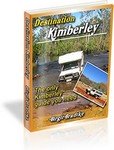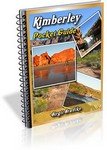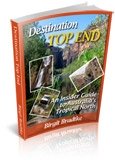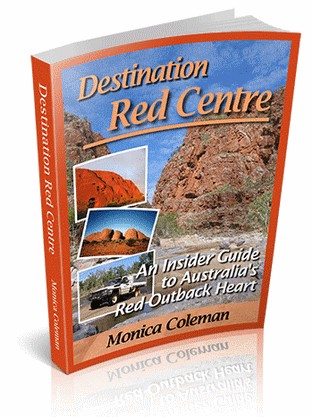Saltwater Crocodiles
The Australian Estuarine or Saltwater Crocodile (Crocodylus porosus) can be found all across the north of Australia, and further north of here.
From the Solomon Islands and Vanuatu across Papua New Guinea, Indonesia, the Philipines, Malaysia, all the way to Vietnam, Cambodia, Thailand and India, and everywhere in between. They can travel over a thousand kilometres by sea, which explains their wide distribution.
However, only the populations in Australia and PNG are stable. Illegal hunting and habitat destruction has severely depleted their numbers elsewhere...
Australian saltwater crocodiles are the largest reptile in the world in terms of mass (can be over 1000kg), and the largest crocodile with a confirmed measurement.
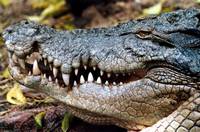
The males can reach a length of up to 6 or 7 metres (2.5 to 3m for females), though such a size is rare.
In fact, anything over 5 metres is rare, but that is more than big enough anyway. This is a large headed species with a heavy set of jaws, and the jaws can exert a pressure of several tons...
"Salties", as we "Aussies" call them, eat mainly small reptiles, fish, turtles, wading birds etc..., but they can also kill and eat much larger prey. They are known to take wild pigs, buffaloes, and also live stock like cattle and horses.
The name saltwater crocodile is misleading. Salties can live in the brackish waters along the coastlines but are just as happy in freshwater rivers, swamps and billabongs many hundred kilometres inland.
Breeding and raising of the young saltwater crocodiles actually happens in freshwater areas. Between November and March the female lays 40 - 60 eggs in a nest made from plant matter and mud on a river bank. The location of the nests is sometimes used as an indication of how much rain can be expected during the upcoming wet season... However, the crocodiles don't always get it right. Many nests are flooded every year, killing the embryos.
The mother guards the nest, even preventing it from drying out if necessary by splashing it with water. The eggs take 90 days to develop. Interestingly the sex of the young saltwater crocodiles is determined by the incubation temperature. Below 30oC the hatchlings will be female, and above 32oC they will be male.
When the little crocs are about to hatch they make chirping sounds in their eggs, and the mother helps them by digging them out of the nest. Then she takes the hatchlings to the water's edge in her mouth and from here on watches over them until they are able to look after themselves.
It takes females 10 to 12 years, and males 16 years and more to reach maturity... Despite mum's caring ways less than 1% of the hatchlings will get there. Predation by turtles and goannas takes its toll in the early days, and later on the juveniles are often killed and eaten by territorial mature males.
The territorial behaviour of the male saltwater crocodiles forces the young crocodiles out of the region in which they have been raised. They have to find an unoccupied territory for themselves. If they are unable to do that they will either be killed or be forced out to sea. Here they will move around until they find another river system.
Saltwater Crocodile Conservation
You might have heard or read that today there are more saltwater crocodiles living in the Northern Territory than Territorians. I'm not sure about that, but there are certainly more crocodiles than people in the Kimberley...
The Australian saltwater crocodile population is estimated to be over 150,000. That makes Australia a major stronghold of the species, and possibly the only one...
Things didn't always look so good for our saltwater crocodiles.
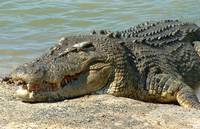
From the late 1940s to the 1970s extensive hunting for their hides (the most valuable of all crocodile skins) had reduced their numbers to a critical level. Their reputation as a man-eater didn't help them much either. The two facts combined made crocodiles just about disappear in other countries that previously had healthy populations.
When saltwater crocodiles were finally made a protected species their numbers slowly recovered. Today several breeding programs exist in Australia, for skin and meat production. For this eggs are collected from the wild.
(There are two crocodile farms in the Kimberley, in Wyndham and Broome.)
(Update: the farm in Wyndham has since closed down.)
The egg collection so far hasn't shown any detrimental effect on the population numbers. Neither has the permission of limited hunting that was given to native people of the area. The numbers are so good that some regulated trophy hunting is being discussed...
Aggressive trapping of problem crocodiles and their removal to crocodile farms has reduced the numbers of conflicts between humans and reptiles. Despite the trapping and ongoing education campaigns there are many calls by residents to start shooting crocodiles again.
All of the Kimberley with its abundance of tidal rivers is perfect habitat for saltwater crocodiles.
I moved here over 12 years ago. Back then it was safe to swim in our lake, and in several places along some rivers. Not any more... The territorial nature of the males requires every mature male to have its own territory. As saltwater crocodile numbers increase they move further and further inland, and closer and closer to human settlements. We have been watching it with our own eyes for years. The potential for conflict is certainly there. Monitoring and trapping helps, but it doesn't eliminate all risk.
Be crocodile safe in the Kimberley.
Travelling to the Kimberley?
 The free Kimberley Pocket Guide
The free Kimberley Pocket Guide
is a great introduction to travel in the region.
The full Kimberley Travel Guide 
shows you how to make the most of your adventure at Australia's last frontier.
Travelling to the Northern Territory?
Destination Top End offers the same comprehensive, detailed insider information for the tropical regions of the Northern Territory.
A must have if you travel to or from Darwin.
NEW! Destination Red Centre is the latest addition in this popular series. Monica Coleman takes you through Australia's red Outback heart, offering all the detail and insider tips that you have come to know and love about our guides. With special emphasis on Aboriginal communities and culture.
A must have if you travel to or from Alice Springs/Uluru.
Kimberley Australia Travel Guide home page

